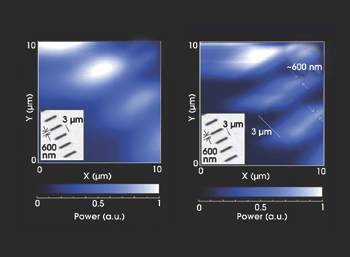Daniel S. Burgess
Researchers in China have demonstrated a near-field scanning optical microscope that employs a very small aperture laser diode as the probe, rather than a tapered optical fiber with a subdiffraction-limited aperture. The approach promises to boost the illumination on the sample by orders of magnitude, increasing the scanning speed and signal-to-noise ratio of the systems.

The potential of the very small aperture laser to act as an active probe for near-field scanning optical microscopy was tested by scanning a sample grating with 600-nm-wide grooves and a period of 3.6 μm. The shape and separation of the grooves becomes clearer as the laser approaches the grating. Courtesy of Qiaoqiang Gan.
Qiaoqiang Gan of the Institute of Semiconductors at the Chinese Academy of Sciences in Beijing suggested that the higher powers also could enable applications of near-field scanning optical microscopy in ultrahigh-density data storage, in nanolithography, and in biology and chemistry as an optical tweezers apparatus. Gan collaborated on the work with researchers from the nano-optoelectronics lab at the institute and from Fudan University and the National Key Laboratory of Nano/Micro Fabrication Technology at Shanghai Jiao Tong University, both in Shanghai.
Various groups have considered the very small aperture laser for such applications in the past few years, since its development at Bell Labs in Murray Hill, N.J. (see “Lasers Benefit Data Storage, Near-Field Optics,” Photonics Spectra, November 1999, page 48). The devices essentially are standard laser diodes to which a thin metal coating is applied on the output facet. Part of this coating is removed, such as by using focused ion beam etching, to create an aperture of the desired shape and size.

The team in China has demonstrated that the theory behind such applications is sound. Unfortunately, translating it into practice remains a challenge. The problem involves identifying a means to maintain the output facet of the laser at the very small distances from the sample as needed. In a traditional system, the tapered fiber probe is kept at a constant height in the near field using an oscillating crystal tuning fork and shear force feedback. A laser diode, however, is too heavy for this configuration, damping the oscillation of the tuning fork.
The investigators have presented an alternative that works for samples that are thin metal films. When the metal output facet of the laser approaches the sample, they form a plane capacitor. The capacitance is inversely proportional to the distance of the planes, so it can be used as a source of feedback for keeping the desired height of the probe above the sample.To validate the method, they employed as the active probe a 650-nm edge-emitting laser diode with a 300 × 300-nm square aperture in a 100-nm-thick gold film. An inductance/capacitance/resistance meter monitored changes in the capacitance. With this system, they resolved the features on gold gratings with 600-nm-wide grooves and a 3.6-μm period and with 400-nm-wide grooves and a 1-μm period.
This still does not make the setup a viable replacement for traditional near-field scanning optical microscopes, however. Because the output facet of the laser is not a tip but a relatively large (approximately 250 × 110 μm) plate, Gan said, it is too easy for it to become nonparallel with the sample, moving the aperture out of the near field or leading to a collision that can damage the surface or the probe.
As a result, the scientists are considering avoiding the near-field scanning mode and instead turning to very small aperture lasers modulated by surface plasmons that display an angular divergence on the order of 3°. They hope that employing such devices, which feature an additional periodic texture around the aperture, will enable them to lengthen the distance to the sample to 1 to 2 μm, simplifying the control of the system.
Applied Physics Letters, March 20, 2006, 121111.